Family : Blenniidae

Text © Giuseppe Mazza

English translation by Mario Beltramini
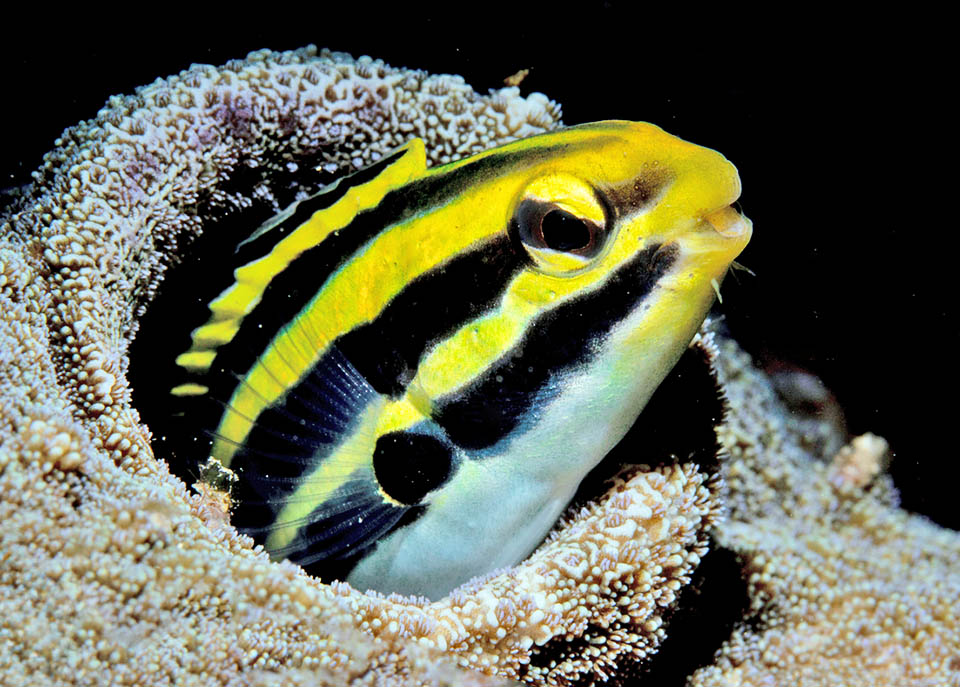
The Striped poison-fang blenny (Meiacanthus grammistes) covers a vast range from Indochina to Australia and New Caledonia © Ray Lee
Inserted in the class of the Actinopterygii, the ray-finned fish, the order of the Blenniiformes will never cease to amaze us, rich as it is with about 150 genera and about one thousand species belonging mostly to the family of the Blenniidae, that of the blennies, modestly sized benthic combtooth fish, often having no swim bladder and scales, replaced by a protective mucus.
Meiacanthus grammistes (Valenciennes, 1836), known as Striped poison-fang blenny, belongs like Acanthemblemaria aceroi or Aspidontus taeniatus to the “tube-blennies”, so called because they often live in the tubes left free by the annelids.
But unlike the latter, an impostor who imitates the livery of Labroides dimidiatus to tear away by treachery shreds of flesh or fins to its clients in the cleaning stations with two showy sabre-shaped canines, Meiacanthus grammistes has gone further, transforming them in hollow teeth connected, like vipers, to poison glands.
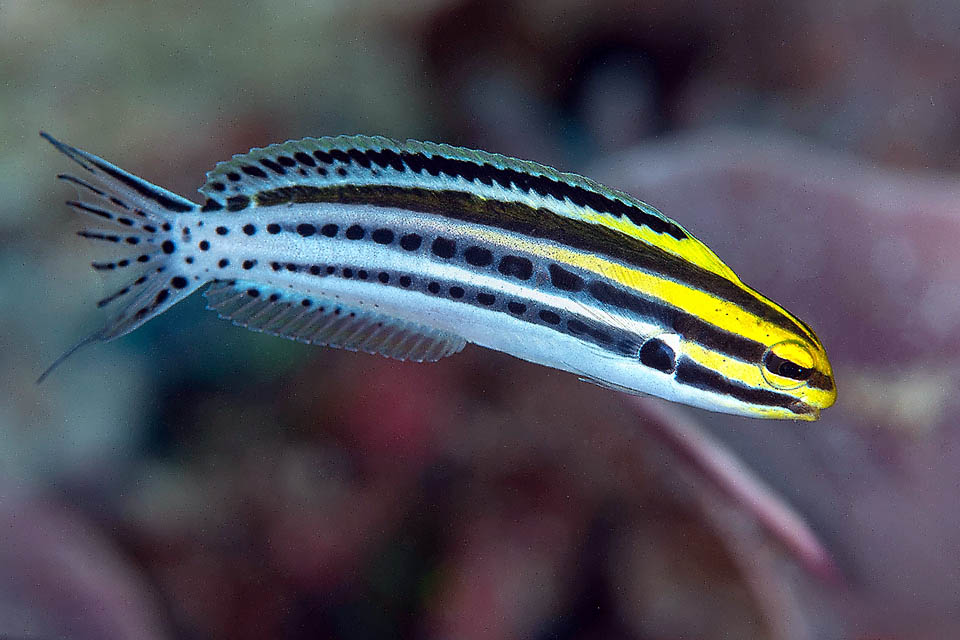
Reaches 11 cm at maximum with an elegant aposematic livery, that the predators associate to unpleasant experiences © Frank Krasovec
Such an effective defense tool, that now there are other unarmed fish, like Petroscirtes breviceps or Cheilodipterus nigrotaeniatus, to imitate its livery to avoid being attacked.
The genus, created by Norman in 1944, is born composed by the Greek “meion”, less, and “acanto” spine, to inform that it’s a fish “with less spines”, seen that the Author compared the spiny rays of the dorsal fin to the more numerous ones of a similar Blenniidae, belonging to the genus Petroscirtes.
The specific term grammistes conversely originates from the Greek “gramma”, drawing, with reference to the three showy dark stripes crossing the body starting from the head and gradually transforming themselves in a dotting on a canary yellow background colour towards the head that then gets silvery shades.
Zoogeography
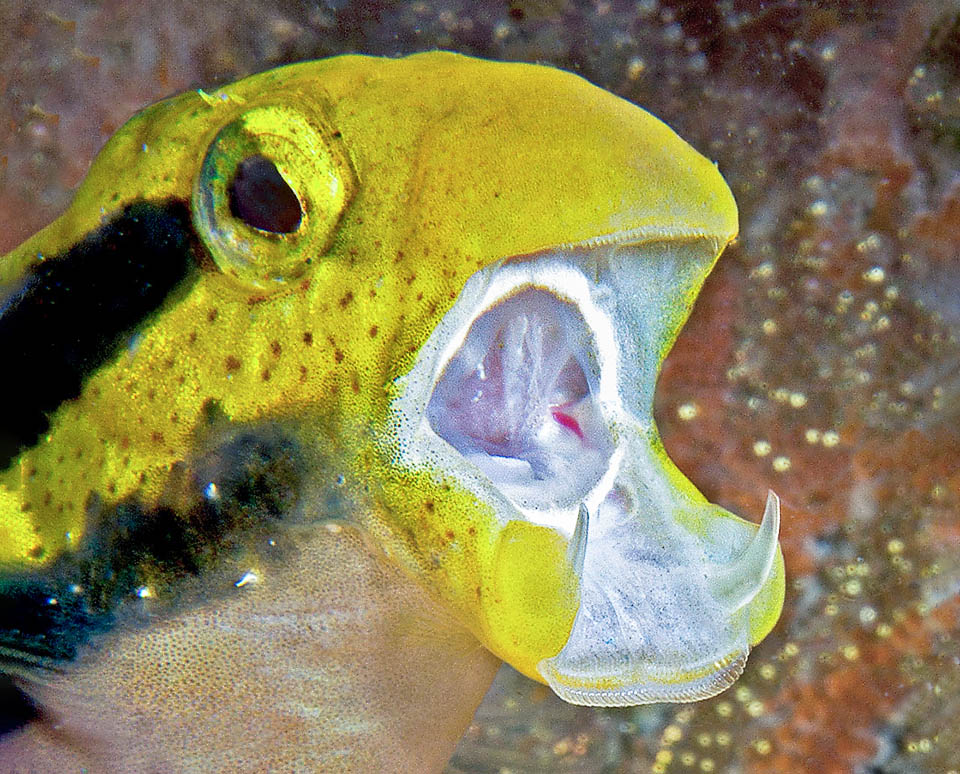
Besides the usual comblike teeth of Blenniidae, well visible here, has in fact two hollow fangs connected, like snakes, with poison glands © Anna & Ned DeLoach
Meiacanthus grammistes is found from the Indochinese peninsula to Papua New Guinea, reaching, north, the Ryukyu Islands, in the southern part of Japan, and south, north-western Australia with the Great barrier reef. Then eastwards, it is present in Micronesia, Salomon Islands and New Caledonia.
Ecology-Habitat
Meiacanthus grammistes lives associated like Aspidontus taeniatus with the coral reef, between 1 and 20 m of depth, but unlike the latter, having no foes, can be found looking for food even far away from home, especially because the presence of a swim bladder allows it to move easily up and down in the water column.
Morphophysiology
Meiacanthus grammistes reaches a maximum length of 11 cm with a fusiform body compressed on the sides.
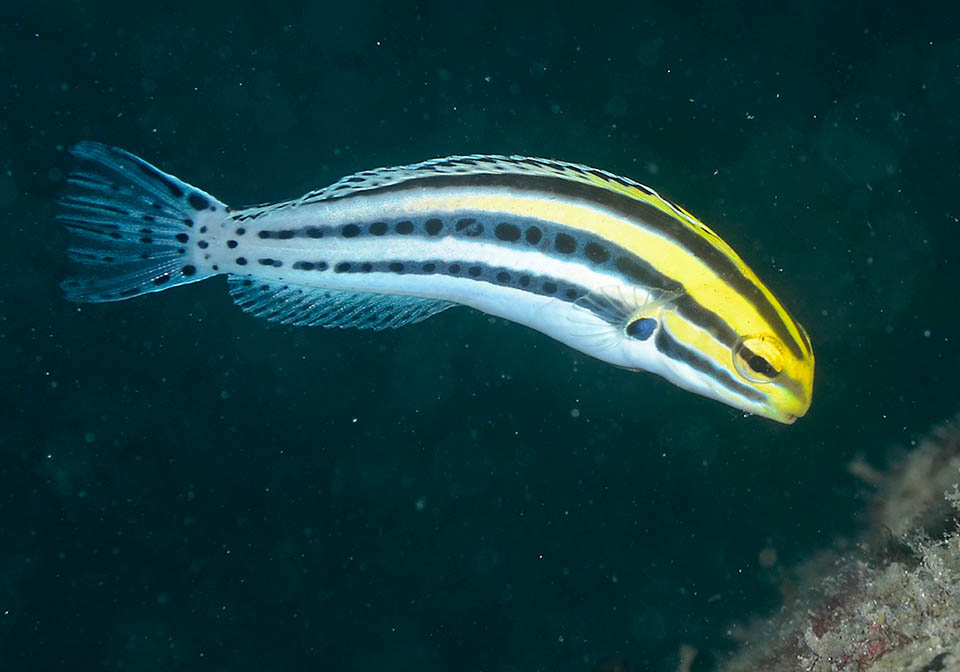
The bite is painless but injects a mixture of drugs that disorient the importunate with sudden drops of blood pressure, giving it plenty of time to get to safety © Benoit Lallement
The body is short and blunt with big eyes, sub-terminal mouth having fleshy lips and the usual rows of comb teeth of the Blenniidae. To these are added on the lower jaw the two above mentioned hollow fangs, that disappear when the mouth is closed in a special lodging between the cranial bones, and carry a particular venom based on opioid peptides having a similar effect to heroin.
The Australian researchers have discovered that it contains also a neuropeptide present in the poisoned darts of the Conidae, marine gastropods common in the tropics with splendid collectible shells, but the unusual thing is that the sting is totally painless.
In the predators it should cause a sudden drop in pressure and disorientation, while the small fish runs away.
The long dorsal fin of Meiacanthus grammistes has 4 spiny rays and 25-28 soft; the anal, 2 spiny rays and 14-16 unarmed. The pelvic ones have one spiny ray and 3 soft and the pectorals 13-16 rays. The large caudal fin is semi-transparent with pronounced rays that continue the outline of the body.
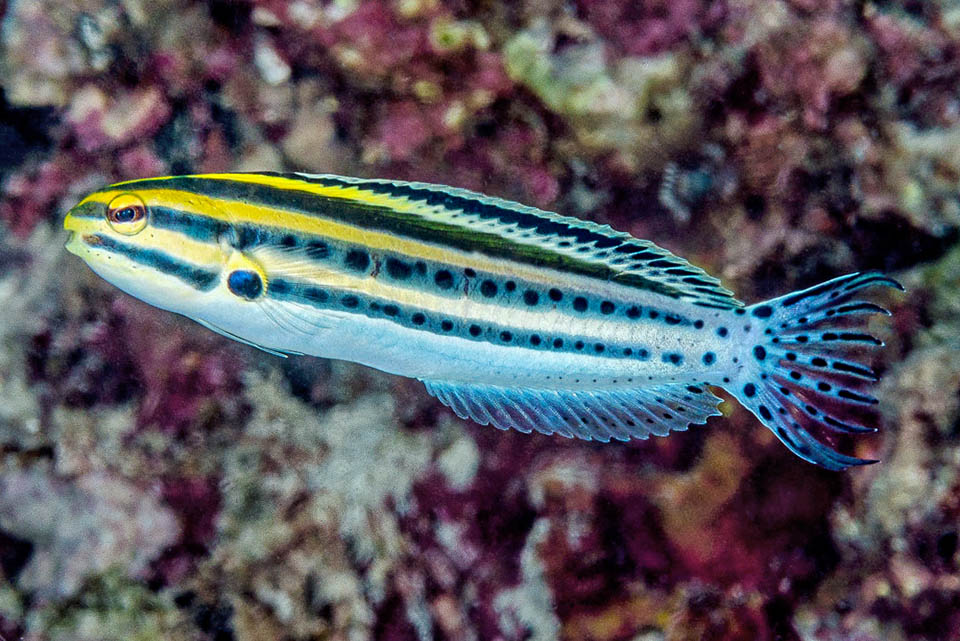
Of course, there is no shortage of imitators of this precious warning livery and Meiacanthus grammistes can search for food even far from home, sure of getting away with it © François Libert
Ethology-Reproductive Biology
The Striped poison-fang blenny often lives solitary feeding on weeds, small crustaceans, eggs and larvae of fish. After having found a suitable den on the seabed, the male attracts a female ready to spawn. The eggs, glued to the substratum, are surveyed until the hatching and the planktonic larvae are frequent in shallow waters.
The resilience is excellent, with a possible doubling of the populations in less than 15 months, and the fishing vulnerability, very low, marks only 10 on a scale of 100. Since 2009 Meiacanthus grammistes therefore appears as “LC, Least Concern” in the IUCN Red List of the endangered species.
Synonyms
Blennechis grammistes Valenciennes, 1836.
→ For general information about FISH please click here.
→ For general information about BONY FISH please click here
→ For general information about CARTILAGINOUS FISH please click here.
→ To appreciate the BIODIVERSITY of BONY FISH please click here.
→ To appreciate the BIODIVERSITY of CARTILAGINOUS FISH please click here.
